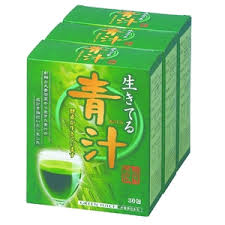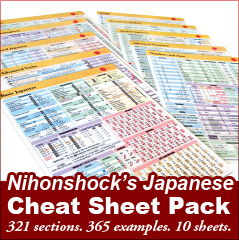Advanced Japanese Colors
Like any language, Japanese possesses a myriad of vivid descriptive terms for color. This article will introduce some interesting differences and quirks about color in the Japanese language, and also offer a selection of beautiful Japanese color names so that learners can expand their vocabulary palette beyond simple (and vague) descriptors such as red, green and blue.
In Japanese, green is the new blue
In ancient Japanese, the four primary colors were black, white, red and blue, and even today the language possesses compound terms for “completely black” (真っ黒 – makkuro), “completely white” (真っ白 – masshiro), “completely red” (真っ赤 – makka), and “completely blue” (真っ青 – massao), but there are no comparable terms for any other colors. The result of this four-color paradigm is a handful of inconsistencies with English and other European languages, particularly involving the colors blue and green.

“blue juice”
Historically, Japanese made no clear distinction between blue and green (green could be considered a shade of blue), and the tendency to call green things blue persists in a number of cases today, such as that stoplights are said to turn blue, not green (青になる – ao ni naru).
Similarly, 青林檎 (aoringo – “blue apples”) and 青野菜 (aoyasai – “blue vegetables”) are certainly not blue, nor is 青汁 (aojiru – “blue juice”). The expression 青臭い (aokusai) means unripe, naive or inexperienced (in English we might call such a person a “greenhorn”).
The Japanese word for “green” (緑 : midori) originally referred to youthful vitality or freshness, and by extension came to refer to “greenery” or trees and plants in general, which—it should be noted—are said to have “blue” leaves (青葉 : aoba).
It’s not like Japanese speakers can’t see the difference; when the specific color of a thing is important, all of them can distinguish between blue and green. But generations-old habits are hard to break; so if your Japanese boss hastily instructs you to go fetch “the blue folder” from somewhere and you can only find a green one, don’t be surprised.
Problematic colors
Color exists on a spectrum and color terms in any language are inherently vague; everything other than pure black and white is always an approximation. Therefore, when dealing with terms across two languages, there are inevitably a number of cases where the descriptors just don’t line up like we expect them to, possibly leading to miscommunication.
For example, Japanese “wisteria” (藤色 – fuji-iro) is less purple and more blue than what we would normally call “wisteria” in English, so if we’re translating the color and not the word, we should call it “periwinkle”. If you don’t feel like being quite so specific then just say “lavender“, which could refer to either color.

“Pink” is usually equated to Japanese’s 桃色 (momo-iro), which is literally “peach-colored”. If you’re good with colors, you probably just raised an eyebrow; yes, “peach” in English is a light shade of orange, not pink. The confusion here is that our English peach color refers to the peach fruit, whereas in Japanese they’re thinking about the flowers of a peach tree.

緋色 (hiiro) is commonly translated as “scarlet” but it actually refers to a color close to vermilion. What English speakers would call “scarlet” would usually be just plain “red” in Japanese (赤 – aka) or alternatively we could use the katakana term スカーレット. If you really just had to come up with a fancy Japanese word you could call it 猩々緋 (shoujouhi), the color of the blood of a fictional red-faced, red-haired sea monster, but this particular term is unfamiliar to most native speakers.

 All the pretty colors
All the pretty colors
The bulk of Japanese’s advanced color lexicon is drawn from nature. 菫 (sumire) is violet the flower and 菫色 (sumire-iro) is violet the color. 桜 (sakura) is the Japanese cherry blossom tree, and 桜色 (sakura-iro) refers to the light pink shade of its blossoms. Although the katakana word オレンジ is more common today, there’s also 橙色 (daidai-iro), 橙 refers to a kind of orange.
Some shades of green tend to mirror very well to English counterparts. 苔 (koke) is moss, so 苔色 is moss green. 千歳緑 (chitose midori – “thousand-years green”) or 常盤色 (tokiwa-iro) is equivalent to English’s “evergreen”. 萌黄色 (moegi-iro) refers to freshly sprouted grass and trees, hence “spring green”. But not all hues are so straightforward; 柳色 (yanagi-iro), literally “willow color” corresponds to our fern or pea green.
There are also colors based on precious stones and materials; 琥珀色 (kohaku-iro) is amber and 翡翠色 (hisui-iro) is jade. There’s also 瑠璃色 (ruri-iro) for lapis lazuli (which isn’t commonly used as a color in English). 真珠色 (shinju-iro – pearl) and 象牙色 (zouge-iro – ivory) are beautiful names for a yellowish off-white color. Sadly, there’s no native Japanese term for turquoise—a mineral not found in Japan—so for that color we’ll have to make due with katakana: ターコイズブルー (“turquoise blue”).
Japanese also draws some color names from birds. What English speakers would call “olive green” is likened to a Japanese bush warbler, 鶯色 (uguisu-iro). 鳶色 (tobi-iro) refers to the reddish-brown feathers of a black kite. And “teal” comes out as 鴨の羽色 (kamo no ha-iro) or “duck feather color”.
One notable oddball is 納戸色 (nando-iro, sometimes preceded with a beautifying お), which literally means “closet color” (umm… come again?). In English we would call the color “aquamarine”.
A couple others that are nice to know are 浅葱色 (asagi-iro), which is the dark cyan color famously used on the shinsengumi‘s haori, and 葡萄色 (ebi-iro), which uses the kanji for “grape” with the reading for “shrimp” to simultaneously refer to the color of grapes and the shell of an (uncooked) lobster.
What Japanese colors do you like?
If you think I missed something (I’m sure I did), leave a comment and I’ll try to keep updating this section.

Note: 朱色 may also refer to cinnabar (a shade of orange)
Conclusion and Further Reading
Having an advanced repertoire of colors in your vocabulary isn’t absolutely necessary, but it does make life more… well… colorful. I expanded and corrected my own knowledge of color (in both Japanese and English) in the course of researching and writing this article, and can proudly claim to be a little bit more sophisticated for it.
If you’d like to see even more named Japanese colors, here’s a couple great links to get you started.
More posts (tagged) like this...
Posted under
Language & Study by Nihonshock.
 All the pretty colors
All the pretty colors












You missed out koniro and shuiro (sorry no kana on this interface) as far as specifically Japanese colours, those to me are the most japanesey. I studied traditional Japanese tattooing in japan for seven years and those two were by far the most ubiquitous.
by: Adam, Jun 23rd at 7:29 pm
I’m sorry, I really did enjoy the article by the way, it was very well researched and informative!
by: Adam, Jun 23rd at 7:31 pm
Thanks for the comment, Adam. I tried to focus on advanced colors, but you’re right; I should have included those two. I’ll go back and add them later on.
by: Lloyd Vincent, Jun 24th at 1:35 am
Wow this seems like a lot of hardwork! Impressive!
by: Stuti, Jan 9th at 3:50 pm
I have a question: A few years back I had read on a couple or three different sites that purple was considered a lighter form of black. Is that so? I can’t seem to find any references to it now, it’s like they’ve all up and vanished. I thought perhaps I had mistaken it for a feng shui belief, but it looks like the lighter form of black is blue in feng shui (black being the more powerful representation of the element water). If you can enlighten me or direct me where I could find more information, I would be most grateful.
by: Kyoumoutora, Jun 8th at 7:42 am